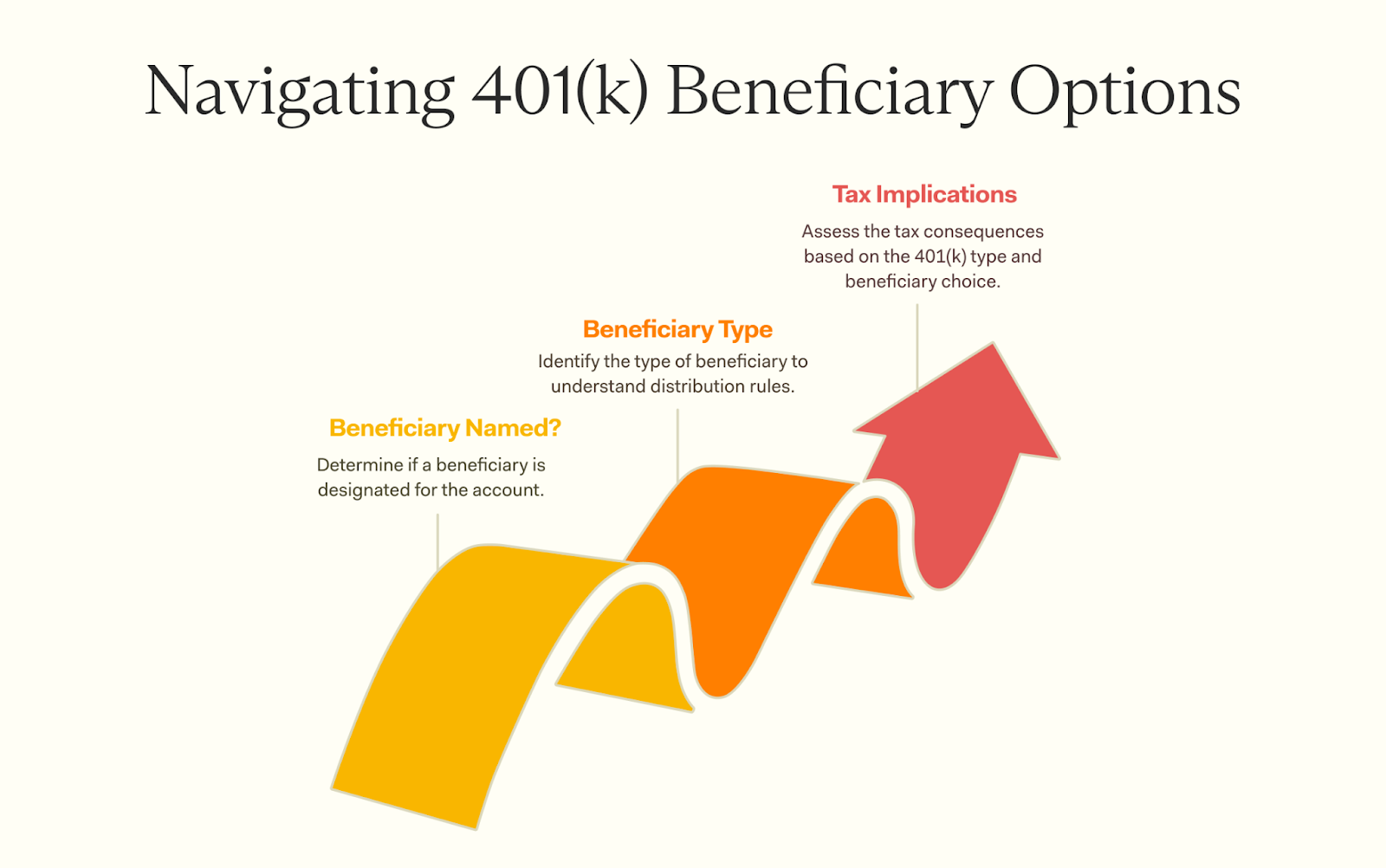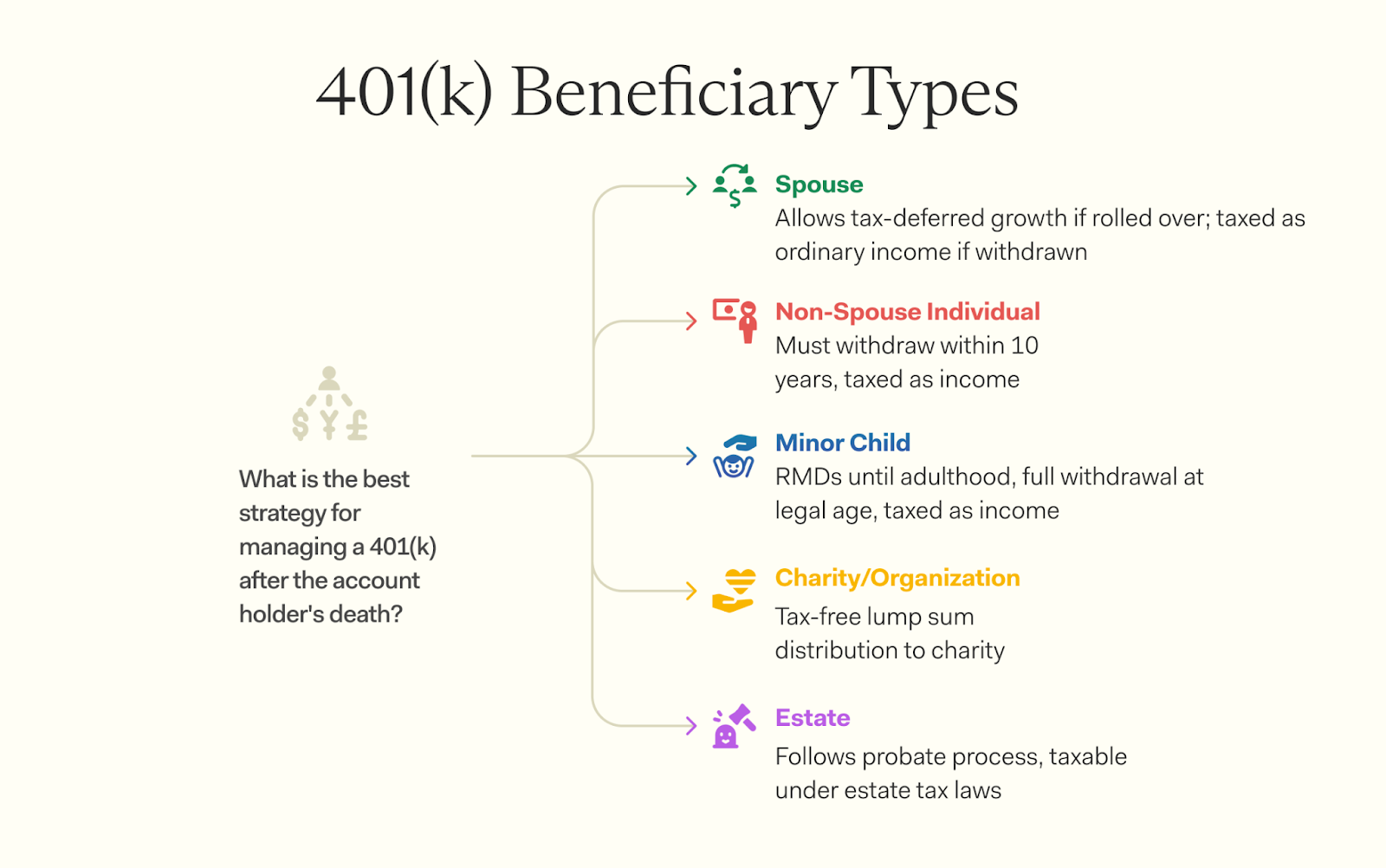Learn what happens to your 401k when you die and how beneficiaries can manage it. Get essential insights and guidance in our helpful guide.
Wondering what happens to your 401(k) when you die? You're not the only one. Many worry about how their retirement accounts will be managed after death. If you've listed beneficiaries, they can receive the funds directly from your 401(k). This avoids the probate process, saving time and money.
This post explains what occurs with your 401(k) after you pass. We cover beneficiaries, distribution rules, and tax effects. Concerned for a surviving spouse or other family members? This information is critical.

After your death, your 401(k) passes to selected beneficiaries. This includes people or entities you've named.
Beneficiaries determine what happens to a 401(k) after the account owner's death. If the owner lists beneficiaries, such as spouses, children, other relatives, friends, or charities, these entities receive the assets.
The plan administrator uses the beneficiary designation form from the original account owner to decide who gets what. Keeping beneficiary designations current is crucial.
When an account has multiple primary or contingent beneficiaries listed, they each may get a specific portion of the assets as directed by the original owner. By federal law, if no beneficiary is named, spouse beneficiaries typically get priority for 401(k) assets.
Without a spouse, non-spouse beneficiaries or standard rules apply. This situation often results in probate court involvement which can delay and complicate asset distribution for surviving family members.
If you don't name a beneficiary for your 401(k), state laws decide what happens. The plan often goes to the account holder's estate. This can lead to delays in payments and extra costs.
Your family might have to go through probate court, which takes time.
The default beneficiary rules can vary by plan. Some plans name the spouse as the first default beneficiary, while others may choose children or other relatives next. It's smart to check your plan's rules now before it's too late.
Failing to designate a beneficiary could create confusion and complications for your loved ones.

The type of beneficiary significantly impacts available options for an inherited 401(k).
Spousal beneficiaries have special rights when they inherit a 401(k). If the account holder dies, the spouse can take over the account. They can choose to roll it into their own retirement plan or keep it as an inherited IRA.
This move allows them to maintain tax benefits.
A spouse can also withdraw funds without penalty, unlike non-spousal beneficiaries. Taxes will still apply on any distributions taken from the account. Spouses should update beneficiary designations regularly to ensure plans align with current wishes.
Non-spousal beneficiaries can claim the 401(k) funds after the account holder's death. This group includes friends, siblings, and even charities or organizations.
They have different options compared to spousal beneficiaries. Non-spousal beneficiaries can't roll over the 401(k) into their own accounts directly. They must withdraw the money instead.
Funds from a 401(k) inherited by these beneficiaries may be taxable income as well. The tax burden can vary significantly based on when they take distributions and how much they withdraw each year.
Minor children can be named as beneficiaries for a 401(k). However, there are special rules to consider. A minor can't access the funds directly until they reach adulthood. This means a guardian must manage the account on their behalf.
If you name a minor child as a beneficiary, it's wise to set up a trust or custodial account. These options help manage the money until your child is old enough. Some employers might require this too.
Funding from these accounts can support your child's education or other needs without immediate tax burdens. Just keep in mind that naming minors affects how taxes apply to distributions and managing those assets responsibly is key.
Charities or organizations can be named as beneficiaries of a 401(k). This means that when the account owner dies, the charity receives the funds. Many people choose this option to support causes they care about.
It's a way to leave a legacy.
Naming a charity is straightforward. You just fill out your beneficiary designation form. If you include multiple charities, you specify how much each one gets. This type of transfer is usually tax-free for charitable organizations.
The funds go directly to them without any taxes taken out, which makes it an attractive choice for both donors and charities alike.
When inheriting a 401(k), beneficiaries face various distribution options. You might choose a lump sum or roll funds into an IRA. Here's how it works.
A lump sum distribution is a way to take all the money from a 401(k) at once. Beneficiaries can choose this option after the original account owner's death. It gives them immediate access to funds, but it's important to note that the entire amount is subject to income tax in the year received, which could significantly increase the beneficiary's taxable income for that year.
Beneficiaries must pay income tax on the amount they receive. This could be higher than expected. If there are multiple primary beneficiaries, they will split the total as per their designated shares.
Choices made now can affect future taxes and spending habits—careful planning helps avoid surprises down the road.
Beneficiaries can choose to roll over the money from a 401(k) into an Individual Retirement Account (IRA). This option helps them avoid taxes right away. The rollover process transfers funds directly from the 401(k) to the IRA without penalties or taxes.
Spousal beneficiaries can roll over the inherited 401(k) into their own retirement account, such as an IRA, allowing them to defer required minimum distributions (RMDs) until they reach age 73. However, if the spousal beneficiary is under 59½ and withdraws funds from the rolled-over account, they may be subject to a 10% early withdrawal penalty. Non-spousal beneficiaries are generally required to withdraw all funds from the inherited 401(k) within 10 years of the original owner's death. If the original owner had already begun taking RMDs, the IRS requires that distributions continue at least as rapidly as they were being taken by the original owner during the 10-year period, with the account fully distributed by the end of the 10th year.
Inheriting a 401(k) comes with tax considerations that vary depending on the beneficiary's relationship to the deceased.
Inherited 401(k) accounts can create taxable income for beneficiaries. This income gets taxed as ordinary income, which means you pay taxes at your usual rate. Your tax bill depends on how much you withdraw in a given year.
Non-spousal beneficiaries face specific rules. They must take distributions within ten years of the account holder's death. These withdrawals are also part of your taxable income. Spousal beneficiaries can roll over the inherited 401(k) into their own retirement account, such as an IRA, deferring required minimum distributions (RMDs) until age 73. However, withdrawals before age 59½ may incur a 10% early withdrawal penalty.
Non-spousal beneficiaries face the 10-Year Rule after inheriting a 401(k). This rule requires them to withdraw all funds from the account within ten years of the original owner's death. If the original owner had begun taking RMDs, distributions must continue at least as rapidly during these ten years, with funds fully distributed by the end of this period.
There are no required minimum distributions during this period unless the original account owner had started taking them. Beneficiaries must then continue taking distributions at least as rapidly as the original owner during the 10-year period, ensuring the account is fully distributed by the end of the 10th year.
Beneficiaries should plan carefully. Withdrawing too much in one year can lead to higher taxes on taxable income. Spreading withdrawals over several years might help reduce tax burdens.
Knowing these rules is key for non-spousal beneficiaries managing their inheritance wisely.
Effective 401(k) estate planning requires vigilance and regular maintenance to ensure your wishes are carried out.
Keeping your beneficiary designations current is essential for your 401(k). Life changes fast. Marriages, divorces, and births can all mean you need to update who gets your money. If you don't list a new beneficiary, the default rules kick in.
This might not match what you want.
Many employers offer options to change this information easily. Check your plan's guidelines often. Keeping these designations current helps ensure that one or more beneficiaries receive what they deserve when you die.
Per stirpes and per capita are two ways to name beneficiaries on a 401(k). With per stirpes, if a beneficiary dies before you, their share goes to their children. This helps keep your assets in the family line.
On the other hand, per capita divides the money equally among surviving beneficiaries. If one beneficiary is gone, their share doesn't go to their kids; it just gets split among those still alive.
Choosing between these designations matters for estate planning. Spousal or non-spousal beneficiaries may have different needs too. It's good to think about how each option affects those left behind. Even charities can be named as beneficiaries under these rules!
Your 401(k) represents more than just retirement savings—it's a significant part of your legacy. When it comes to ensuring these assets transfer smoothly to your loved ones, the details matter.
Don't leave your beneficiary designations to chance. A Farther financial advisor can bring clarity to complex estate rules, tax implications, and beneficiary options that generic online resources simply can't provide.
Ready to protect what you've built? Talk to an advisor today. Your family's financial future is worth the conversation.
Understanding what happens to your 401(k) when you die is essential for proper estate planning. Beneficiaries play a crucial role in this process. They can get the money quickly, depending on how you set it up.
Not naming a beneficiary can lead to complications and default rules take over.
Understanding distribution options helps beneficiaries choose wisely. Taxes are also a big factor, especially for non-spousal beneficiaries. Regularly updating your beneficiary list ensures everything stays current.
Take action now—review your 401(k) plans and talk with an expert if needed. Your choices today will impact those you leave behind tomorrow. Prepare well for their future!
When you pass away, your 401(k) goes to the designated beneficiary listed on the account. This could be a spouse, other family members, friends, or even a legal entity such as an educational institution or nonprofit charity.
Yes, indeed! A spouse beneficiary has the option of a cost-free transfer into their own retirement account. Non-spousal beneficiaries may have different distribution options based on their life expectancy and other factors that could affect their taxable income.
Absolutely! You can designate any legal entity - from an educational institution to a nonprofit charity or even a business - as your beneficiary.
The answer depends largely on who is receiving it and how they opt to take distributions. But generally speaking, yes –– withdrawals will likely count towards the beneficiary's taxable income unless certain conditions are met for tax-free status.
A financial advisor can provide valuable guidance during this significant life event. They'll ensure you're informed about all aspects related to workplace retirement plans including distribution options for various types of beneficiaries.